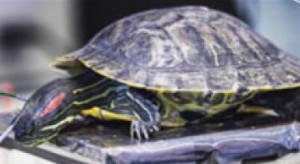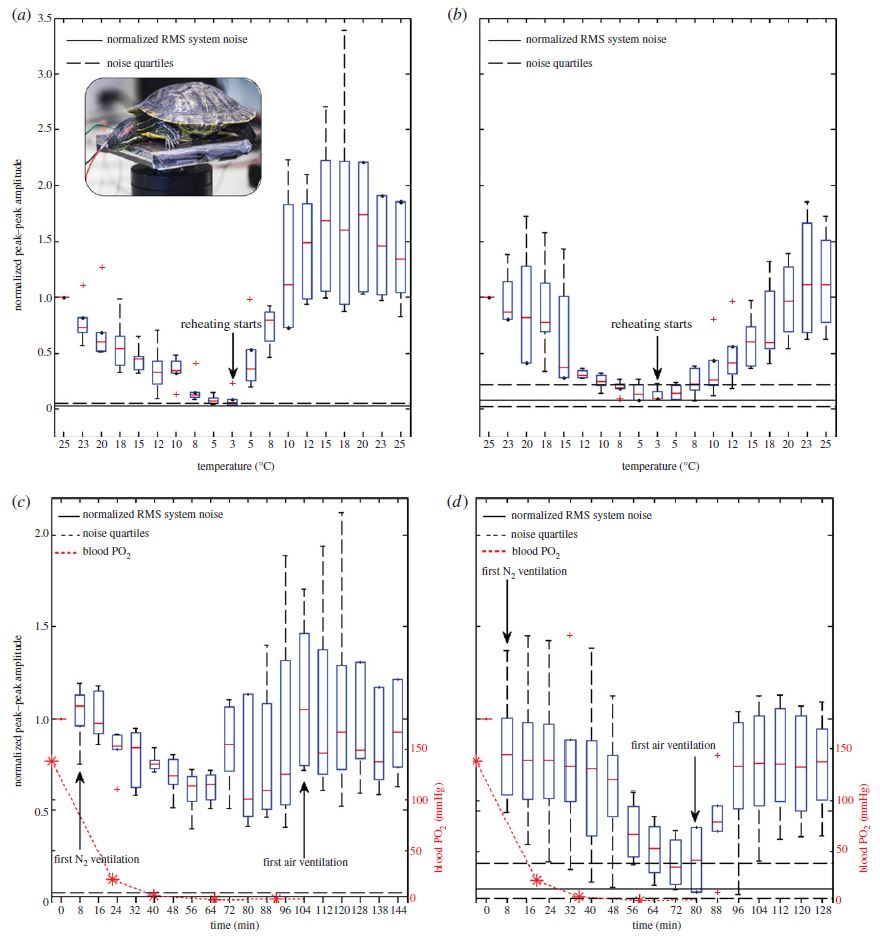Brain Freeze! in hibernating turtles.
The paper: Madsen, J.G. et al. (2013) Detecting spring after a long winter: coma or slow vigilance in cold, hypoxic turtles? Biol Lett 9:20130602. doi:10.1098/rsbl.2013.0602
Subject areas: Physiology
Vocabulary:
hibernation – an state of dormancy to help animals survive the winter; it is usually characterized by very low metabolism, prolonged sleep or even deeper states of inactivity, all to minimize energy use, since the animal is often limited to whatever fat stores it has built up in the time immediately before going into hibernation.
—–
This article is a summary of a recent primary research paper intended for high school teachers to add to their general knowledge of current biology, or to supplement their lessons by showing students the kinds of projects that current biological research addresses.
—–
 As the weather begins to turn colder in many parts of the United States, some of the animals are preparing for hibernation, an extremely-low-metabolic state that allows the animal to essentially sleep through the winter, when food is scarce or nonexistent and environmental conditions are challenging to the survival of the hibernating species. In some species, the animals wake up occasionally throughout the winter to either eat or eliminate waste. Others stay asleep the entire time.
As the weather begins to turn colder in many parts of the United States, some of the animals are preparing for hibernation, an extremely-low-metabolic state that allows the animal to essentially sleep through the winter, when food is scarce or nonexistent and environmental conditions are challenging to the survival of the hibernating species. In some species, the animals wake up occasionally throughout the winter to either eat or eliminate waste. Others stay asleep the entire time.
The freshwater turtle (an air-breathing reptile) passes the winter in a dormant state at the bottom of iced-over ponds, deep enough that the water has not frozen. It is able to do so for the entire winter without breathing in any oxygen. Keep in mind that this is an animal that normally makes its energy using an oxygen-dependent process, which can generate almost twenty times as much ATP (cell-usable energy) from a sugar molecule than generating ATP without oxygen.
Obviously, the turtle must shut down as much of its bodily functions as possible. Nerve cells are very expensive to run, energetically speaking, and previous work has shown an ~80% reduction in neural activity. Since there is such a significant drop, it was thought that the turtle likely enters a comatose state. However, that left open the question of how the turtle knew when to wake up from its hibernation. Madsen and colleagues have investigated that question in this paper.
The turtles (Trachemys scripta) are normally kept in tanks at about 27 C. For the temperature-dependence tests, the turtles were gradually cooled in a water bath down to 3 C over approximately 2 hours. For the anoxia (low/no oxygen) tests, the turtles were placed in a chamber with an oxygen-free air mixture after first having had their lungs purged with nitrogen. For all the tests, the turtles had electrodes implanted between the skin and the skull to measure overall activity in the brain.
Figure 1a shows the change in responsiveness to light during cooling and reheating. Not only does light-induced brain activity recover from very minimal activity at the coldest temperature, but it actually becomes more active than the starting activity well before reaching the start temperature. Brain activity induced by vibration (1b) similarly drops with temperature and comes back up after reheating, but it does not go higher than the original temperature and has a similar level of activity at a given temperature when cooling or heating.
The most interesting finding is shown in 1c. This is light-responsive brain activity in response to anoxia. The dotted red line indicates the amount of oxygen in the turtles’ blood. Surprisingly, there is no change! In contrast, the vibration-sensitive brain activity (1d) dropped significantly with blood oxygen.
Those results were all done with anesthetized turtles (since they had the electrodes implanted in them). In order to verify the results with undrugged turtles, the researchers used an infrared camera to track the turtles’ activity under different conditions as shown below in figure 2. For these experiments, they started with turtles that had been acclimated to a cold anoxic environment for two weeks. As expected, as the temperature rose, the turtles became more active (2a). However, raising the oxygen level in the water did not. Vibration also did not cause much movement, but light caused a strong increase in activity.
All of this seems consistent with a model in which the turtle goes into hibernation by shutting down many of its biological processes, but selectively keeping only a few somewhat active in order to perceive the time to wake up at the end of winter. Light perception is a reliable indicator that the environment is warm enough to wake up because the thawing of the ice on top of a pond will allow more light to reach the bottom. It is also consistent with shutting down vibration detection, as that would not necessarily correlate strongly with the arrival of spring. So, although a lot of the brain activity is shut down, it is not global like a coma, and some key sensory processes are left running to wake the animal out of hibernation at the right time.



No comments
Be the first one to leave a comment.